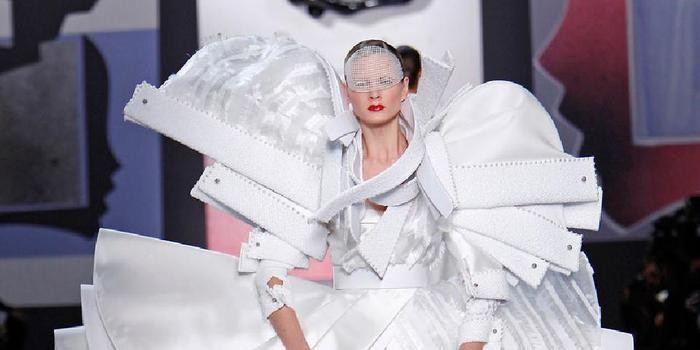The status of fashion within the sphere of fine art has long been the subject of debate. There have been designers who identified themselves first and foremost as artists, such as Elsa Schiaparelli, who declared in her autobiography that she regarded dress design not as “a profession, but an art.” By contrast, many prominent designers of the present day reject this position—including Miuccia Prada, Karl Lagerfeld, and Marc Jacobs—instead viewing fashion and art as their own separate, if highly complementary, realms. In fact, Yves Saint Laurent considered there to be such a gulf between the two fields that he once lamented that, despite his legendary accomplishments as a couturier, “I am a failed painter.”
In 1983, this occasional dispute was brought to the forefront of art criticism and scholarship when the Metropolitan Museum of Art's Costume Institute mounted a 25-year retrospective of Saint Laurent's designs. Displaying the iconic clothes in the same manner and context as masterpieces by Picasso, Monet, and Pollock angered many critics, who were forced to question whether an “applied” or “decorative” art should be elevated to the same platform as fine art.
From one point of view, the main differences between fashion and art could be found in their utility and temporality. Fashion is constrained by certain factors, including wearability and the specific contours of the human body, for instance. It has a clear commercial value, priced as a cross-function of the cost of goods and brand perception. Fashion is ever-evolving, frequently changing based on trends. Those considerations, one could argue, keep fashion distinct from art, in which economic considerations in general are seen as much less important—art is created regardless of its eventual economic value (or lack there of). And the nonutility of art is a key differentiator from fashion, as is the fact that its value increases over time.
Just as fashion is following art, art, too, is steadily adopting characteristics typical of fashion. As art economist Claire McAndrew noted in her book The Art Economy, “no matter how highly valued art is in society, there is no escaping the fact that it is produced, bought, and sold by individuals and institutions working within an economic framework inescapable from material and market constraints,” a fact that is largely a byproduct of an increasingly global art market. Artists today have become brand names, with many investors looking less at the aesthetic or formal qualities of an artwork and instead examining an artist’s sales history and “brand value.”
In turn, many contemporary artists (like, most famously, Damien Hirst and Takashi Murakami) have made art's function as a market commodity a core aspect of their work. Leveraging their brand identities, artists have often partnered with fashion designers to create wildly popular clothing collaborations, such as Murakami's Louis Vuitton bags. And anyone who doesn't believe that art follows trends has never toured an art fair, where common approaches to a perceived opening in art history often lead to a profusion of similar objects made by artists all over the world. (Just see our trend report from Armory Week to discover a couple of these.)
When considering the changing dynamics of the art and fashion worlds—particularly over the past 50 years—the distinctions between fashion and art in the traditional sense become almost nonexistent. So... fashion is clearly art, right? Well, in my view, not quite. Fashion and art share more of a symbiotic relationship, as two different means of creative self-expression that profit from frequent interchange. There is no doubt that fashion demands a rightful place in the museum, and should be valued for its contribution to our visual culture. Fashion shows today are so elaborate and conceptual that it's difficult not to consider them a form of performance art, and I would be hard-pressed to dispute anyone who declared that certain haute-couture looks from avant-garde designers like Viktor & Rolf, Hussein Chalayan, and Alexander McQueen are true works of art.
Yet, the intrinsic difference between fashion and art remains, namely as it relates to utility—just as there is a distinction between design, where an object is created to fulfill a functional need, and art, where artworks largely fulfill non-functional (spiritual, for instance) needs. There's a reason fashion designers are called "designers," after all. Karl Lagerfeld may have put it best: “Art is art. Fashion is fashion. However, Andy Warhol proved that they can exist together.”
On Trend is a monthly column on fashion and art by Meredith Blechman. See her previous column here.























